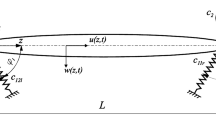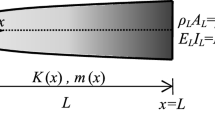Abstract
Purpose
In this paper, free vibration of polynomial and exponential axially functionally graded (AFG) beam with lumped end masses and elastic supports is studied within the Euler–Bernoulli beam theory. The axial eccentricity and rotatory inertia of the end lumped masses are considered. Also, a new equation is proposed for the equivalence of the exponential AFG beams with the polynomial AFG beams.
Methods
Both the geometrical and material properties of the beam are graded along the AFG beam axis according to the polynomial (P-AFG) and exponential (E-AFG) functions. An analytical approach to derive the exact characteristic equations of two types of AFG beams with end lumped masses and elastic supports is presented. Accordingly, through numerical solving of the characteristic equations, the exact natural frequencies of AFG beams with arbitrary boundary conditions are obtained.
Results and Conclusion
The effects of end lumped mass parameters, i.e., end mass ratio, rotatory inertia ratio, axial eccentricity ratio, the AFG parameters, and the end support parameters on the first three natural frequencies of several P-AFG beams and their equivalent E-AFG beams are investigated. Results show the mentioned parameters play an important role in determining the natural frequencies for the AFG beams. Moreover, the present results can use as a benchmark for other numerical solutions and be served for purposeful design vibrating a wide range of non-uniform and composite beams.














Similar content being viewed by others
References
Bambaeechee M (2019) Free vibration of AFG beams with elastic end restraints. Steel Compos Struct 33:403–432. https://doi.org/10.12989/scs.2019.33.3.403
Singh KV, Li G (2009) Buckling of functionally graded and elastically restrained non-uniform columns. Compos Part B Eng 40:393–403. https://doi.org/10.1016/j.compositesb.2009.03.001
Banerjee JR (2001) Explicit analytical expressions for frequency equation and mode shapes of composite beams. Int J Solids Struct 38:2415–2426. https://doi.org/10.1016/S0020-7683(00)00100-1
Wu L, Wang Q, Elishakoff I (2005) Semi-inverse method for axially functionally graded beams with an anti-symmetric vibration mode. J Sound Vib 284:1190–1202. https://doi.org/10.1016/j.jsv.2004.08.038
Singh KV, Li G, Pang S-S (2006) Free vibration and physical parameter identification of non-uniform composite beams. Compos Struct 74:37–50. https://doi.org/10.1016/j.compstruct.2005.03.015
Aydogdu M, Taskin V (2007) Free vibration analysis of functionally graded beams with simply supported edges. Mater Des 28:1651–1656. https://doi.org/10.1016/j.matdes.2006.02.007
Huang Y, Li X-F (2010) A new approach for free vibration of axially functionally graded beams with non-uniform cross-section. J Sound Vib 329:2291–2303. https://doi.org/10.1016/j.jsv.2009.12.029
Shahba A, Attarnejad R, Marvi MT, Hajilar S (2011) Free vibration and stability analysis of axially functionally graded tapered Timoshenko beams with classical and non-classical boundary conditions. Compos Part B Eng 42:801–808. https://doi.org/10.1016/j.compositesb.2011.01.017
Shahba A, Attarnejad R, Hajilar S (2013) A mechanical-based solution for axially functionally graded tapered Euler–Bernoulli beams. Mech Adv Mater Struct 20:696–707. https://doi.org/10.1080/15376494.2011.640971
Wang D (2012) Frequency sensitivity analysis for beams carrying lumped masses with translational and rotary inertias. Int J Mech Sci 65:192–202. https://doi.org/10.1016/j.ijmecsci.2012.10.002
Li X-F, Kang Y-A, Wu J-X (2013) Exact frequency equations of free vibration of exponentially functionally graded beams. Appl Acoust 74:413–420. https://doi.org/10.1016/j.apacoust.2012.08.003
Li XF (2013) Free vibration of axially loaded shear beams carrying elastically restrained lumped-tip masses via asymptotic Timoshenko beam theory. J Eng Mech 139:418–428. https://doi.org/10.1061/(ASCE)EM.1943-7889.0000403
Zhang H, Kang YA, Li X-F (2013) Stability and vibration analysis of axially-loaded shear beam-columns carrying elastically restrained mass. Appl Math Model 37:8237–8250. https://doi.org/10.1016/j.apm.2013.03.050
Tang A-Y, Wu J-X, Li X-F, Lee KY (2014) Exact frequency equations of free vibration of exponentially non-uniform functionally graded Timoshenko beams. Int J Mech Sci 89:1–11. https://doi.org/10.1016/j.ijmecsci.2014.08.017
Su H, Banerjee JR (2015) Development of dynamic stiffness method for free vibration of functionally graded Timoshenko beams. Comput Struct 147:107–116. https://doi.org/10.1016/j.compstruc.2014.10.001
Yuan J, Pao Y-H, Chen W (2016) Exact solutions for free vibrations of axially inhomogeneous Timoshenko beams with variable cross section. Acta Mech 227:2625–2643. https://doi.org/10.1007/s00707-016-1658-6
Calim FF (2016) Free and forced vibration analysis of axially functionally graded Timoshenko beams on two-parameter viscoelastic foundation. Compos Part B Eng 103:98–112. https://doi.org/10.1016/j.compositesb.2016.08.008
Rezaiee-Pajand M, Hozhabrossadati SM (2016) Analytical and numerical method for free vibration of double-axially functionally graded beams. Compos Struct 152:488–498. https://doi.org/10.1016/j.compstruct.2016.05.003
Nikolić A (2017) Free vibration analysis of a non-uniform axially functionally graded cantilever beam with a tip body. Arch Appl Mech 87:1227–1241. https://doi.org/10.1007/s00419-017-1243-z
Lee JW, Lee JY (2017) Free vibration analysis of functionally graded Bernoulli–Euler beams using an exact transfer matrix expression. Int J Mech Sci 122:1–17. https://doi.org/10.1016/j.ijmecsci.2017.01.011
Šalinić S, Obradović A, Tomović A (2018) Free vibration analysis of axially functionally graded tapered, stepped, and continuously segmented rods and beams. Compos Part B Eng 150:135–143. https://doi.org/10.1016/j.compositesb.2018.05.060
Keshmiri A, Wu N, Wang Q (2018) Vibration analysis of non-uniform tapered beams with nonlinear FGM properties. J Mech Sci Technol 32:5325–5337. https://doi.org/10.1007/s12206-018-1031-x
Sınır S, Çevik M, Sınır BG (2018) Nonlinear free and forced vibration analyses of axially functionally graded Euler–Bernoulli beams with non-uniform cross-section. Compos Part B Eng 148:123–131. https://doi.org/10.1016/j.compositesb.2018.04.061
Mahmoud MA (2019) Natural frequency of axially functionally graded, tapered cantilever beams with tip masses. Eng Struct 187:34–42. https://doi.org/10.1016/j.engstruct.2019.02.043
Sun D-L, Li X-F (2019) Initial value method for free vibration of axially loaded functionally graded Timoshenko beams with nonuniform cross section. Mech Based Des Struct Mach 47:102–120. https://doi.org/10.1080/15397734.2018.1526690
Chen Y, Song Z, Li F (2020) Generating mechanism of mode localization for the beams and its application in the passive vibration control. J Sound Vib 485:115531. https://doi.org/10.1016/j.jsv.2020.115531
Chen W-R, Chang H (2021) Vibration analysis of bidirectional functionally graded Timoshenko beams using Chebyshev collocation method. Int J Struct Stab Dyn 21:2150009. https://doi.org/10.1142/S0219455421500097
Li Z, Xu Y, Huang D (2021) Analytical solution for vibration of functionally graded beams with variable cross-sections resting on Pasternak elastic foundations. Int J Mech Sci 191:106084. https://doi.org/10.1016/j.ijmecsci.2020.106084
Sahu RP, Sutar MK, Pattnaik S (2022) A generalized finite element approach to the free vibration analysis of non-uniform axially functionally graded beam. Sci Iran 29:556–571. https://doi.org/10.24200/sci.2021.57274.5151
Liu X, Chang L, Banerjee JR, Dan H-C (2022) Closed-form dynamic stiffness formulation for exact modal analysis of tapered and functionally graded beams and their assemblies. Int J Mech Sci 214:106887. https://doi.org/10.1016/j.ijmecsci.2021.106887
Özdemir Ö (2022) Vibration and buckling analyses of rotating axially functionally graded nonuniform beams. J Vib Eng Technol. https://doi.org/10.1007/s42417-022-00453-8
Bambaeechee M (2022) Free transverse vibration of general power-law NAFG beams with tip masses. J Vib Eng Technol. https://doi.org/10.1007/s42417-022-00519-7
Özmen U, Özhan BB (2022) Computational modeling of functionally graded beams: a novel approach. J Vib Eng Technol. https://doi.org/10.1007/s42417-022-00515-x
Gupta B, Sharma P, Rathore SK (2022) A new numerical modeling of an axially functionally graded piezoelectric beam. J Vib Eng Technol. https://doi.org/10.1007/s42417-022-00550-8
Akgöz B, Civalek Ö (2013) Free vibration analysis of axially functionally graded tapered Bernoulli–Euler microbeams based on the modified couple stress theory. Compos Struct 98:314–322. https://doi.org/10.1016/j.compstruct.2012.11.020
Zeighampour H, Tadi Beni Y (2015) Free vibration analysis of axially functionally graded nanobeam with radius varies along the length based on strain gradient theory. Appl Math Model 39:5354–5369. https://doi.org/10.1016/j.apm.2015.01.015
Kiani K (2016) Thermo-elasto-dynamic analysis of axially functionally graded non-uniform nanobeams with surface energy. Int J Eng Sci 106:57–76. https://doi.org/10.1016/j.ijengsci.2016.05.004
Shafiei N, Kazemi M, Ghadiri M (2016) Nonlinear vibration of axially functionally graded tapered microbeams. Int J Eng Sci 102:12–26. https://doi.org/10.1016/j.ijengsci.2016.02.007
Shafiei N, Kazemi M, Safi M, Ghadiri M (2016) Nonlinear vibration of axially functionally graded non-uniform nanobeams. Int J Eng Sci 106:77–94. https://doi.org/10.1016/j.ijengsci.2016.05.009
Şimşek M (2016) Nonlinear free vibration of a functionally graded nanobeam using nonlocal strain gradient theory and a novel Hamiltonian approach. Int J Eng Sci 105:12–27. https://doi.org/10.1016/j.ijengsci.2016.04.013
Ghayesh MH, Farokhi H, Gholipour A, Tavallaeinejad M (2017) Nonlinear bending and forced vibrations of axially functionally graded tapered microbeams. Int J Eng Sci 120:51–62. https://doi.org/10.1016/j.ijengsci.2017.03.010
Ghayesh MH (2018) Mechanics of tapered AFG shear-deformable microbeams. Microsyst Technol 24:1743–1754. https://doi.org/10.1007/s00542-018-3764-y
Ghayesh MH (2019) Viscoelastic dynamics of axially FG microbeams. Int J Eng Sci 135:75–85. https://doi.org/10.1016/j.ijengsci.2018.10.005
Ghayesh MH, Farajpour A (2019) A review on the mechanics of functionally graded nanoscale and microscale structures. Int J Eng Sci 137:8–36. https://doi.org/10.1016/j.ijengsci.2018.12.001
Zheng S, Chen D, Wang H (2019) Size dependent nonlinear free vibration of axially functionally graded tapered microbeams using finite element method. Thin Walled Struct 139:46–52. https://doi.org/10.1016/j.tws.2019.02.033
Li H-C, Ke L-L (2021) Size-dependent vibration and dynamic stability of AFG microbeams immersed in fluid. Thin Walled Struct 161:107432. https://doi.org/10.1016/j.tws.2020.107432
Abouelregal AE, Mohammed WW, Mohammad-Sedighi H (2021) Vibration analysis of functionally graded microbeam under initial stress via a generalized thermoelastic model with dual-phase lags. Arch Appl Mech 91:2127–2142. https://doi.org/10.1007/s00419-020-01873-2
Mehdipour I, Barari A, Domairry G (2011) Application of a cantilevered SWCNT with mass at the tip as a nanomechanical sensor. Comput Mater Sci 50:1830–1833. https://doi.org/10.1016/j.commatsci.2011.01.025
Rao SS (2019) Vibration of Continuous Systems. Wiley, Hoboken
Wang CY, Wang CM (2012) Exact vibration solution for exponentially tapered cantilever with tip mass. J Vib Acoust 134:041012-1–041012-4. https://doi.org/10.1115/1.4005835
Wang CY (2013) Vibration of a tapered cantilever of constant thickness and linearly tapered width. Arch Appl Mech 83:171–176. https://doi.org/10.1007/s00419-012-0637-1
Wang CY, Wang CM (2013) Structural vibration: exact solutions for strings, membranes, beams, and plates. CRC Press, Boca Raton
Lai H-Y, Chen C-K, Hsu J-C (2008) Free vibration of non-uniform Euler–Bernoulli beams by the Adomian modified decomposition method. CMES Comput Model Eng Sci 34:87–115. https://doi.org/10.3970/cmes.2008.034.087
Rezaiee-Pajand M, Shahabian F, Bambaeechee M (2015) Buckling analysis of semi-rigid gabled frames. Struct Eng Mech 55:605–638. https://doi.org/10.12989/sem.2015.55.3.605
Hsu CP, Hung CF, Liao JY. A Chebyshev spectral method with null space approach for boundary-value problems of Euler-Bernoulli beam. https://www.hindawi.com/journals/sv/2018/2487697/
Wu J-S, Chen C-T (2005) An exact solution for the natural frequencies and mode shapes of an immersed elastically restrained wedge beam carrying an eccentric tip mass with mass moment of inertia. J Sound Vib 286:549–568. https://doi.org/10.1016/j.jsv.2004.10.008
Auciello NM (1996) Transverse vibrations of a linearly tapered cantilever beam with tip mass of rotary inertia and eccentricity. J Sound Vib 194:25–34. https://doi.org/10.1006/jsvi.1996.0341
Nikolić A, Šalinić S (2017) A rigid multibody method for free vibration analysis of beams with variable axial parameters. J Vib Control 23:131–146. https://doi.org/10.1177/1077546315575818
Hozhabrossadati SM (2015) Exact solution for free vibration of elastically restrained cantilever non-uniform beams joined by a mass-spring system at the free end. IES J Part Civ Struct Eng 8:232–239. https://doi.org/10.1080/19373260.2015.1054957
Funding
This research did not receive any specific grant from funding agencies in the public, commercial, or not-for-profit sectors.
Author information
Authors and Affiliations
Corresponding author
Ethics declarations
Conflict of interest
The author declares no known competing financial interests or personal relationships that could have appeared to influence the work reported in this paper.
Additional information
Publisher's Note
Springer Nature remains neutral with regard to jurisdictional claims in published maps and institutional affiliations.
Appendix 1
Appendix 1
The elements of matrix F which are used in Eq. (20) for the P-AFG beam are as follows:
The elements of matrix F which are used in Eq. (20) for the E-AFG beam are as follows:
Rights and permissions
Springer Nature or its licensor (e.g. a society or other partner) holds exclusive rights to this article under a publishing agreement with the author(s) or other rightsholder(s); author self-archiving of the accepted manuscript version of this article is solely governed by the terms of such publishing agreement and applicable law.
About this article
Cite this article
Bambaeechee, M. Exact Frequencies for Free Vibration of Exponential and Polynomial AFG Beams with Lumped End Masses and Elastic Supports. J. Vib. Eng. Technol. 11, 2903–2926 (2023). https://doi.org/10.1007/s42417-022-00720-8
Received:
Revised:
Accepted:
Published:
Issue Date:
DOI: https://doi.org/10.1007/s42417-022-00720-8




